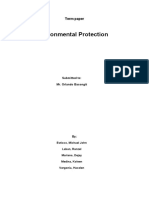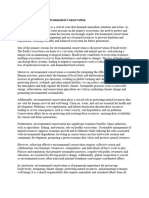环境保护口语话题 environment
环境保护口语话题 environment
Uploaded by
michellexuxuxuCopyright:
Available Formats
环境保护口语话题 environment
环境保护口语话题 environment
Uploaded by
michellexuxuxuOriginal Title
Copyright
Available Formats
Share this document
Did you find this document useful?
Is this content inappropriate?
Copyright:
Available Formats
环境保护口语话题 environment
环境保护口语话题 environment
Uploaded by
michellexuxuxuCopyright:
Available Formats
1.
Climate Change and Its Impact
- What is climate change?
- How does climate change affect weather patterns?
- What are the consequences of rising global temperatures?
Climate change refers to significant changes in global temperatures and weather patterns over
time. While climate change is a natural phenomenon, recent trends are largely attributed to
human activities, such as burning fossil fuels and deforestation. Rising global temperatures lead
to severe weather events like hurricanes, droughts, and heatwaves, impacting ecosystems and
human societies.
2. The Importance of Recycling
- What materials can be recycled?
- How does recycling benefit the environment?
- What are some challenges with recycling?
Materials like paper, glass, metals, and certain plastics can be recycled. Recycling reduces the
need for raw materials, conserving natural resources and reducing pollution from manufacturing
processes. Challenges include contamination of recyclables, lack of public awareness, and the
need for better recycling infrastructure.
3. Deforestation and Its Effects
- What causes deforestation?
- How does deforestation impact wildlife and the climate?
- What can be done to prevent deforestation?
Deforestation is primarily caused by logging, agriculture, and urban expansion. It results in
habitat loss for millions of species, reducing biodiversity. Deforestation also contributes to climate
change by increasing carbon dioxide levels in the atmosphere. Preventive measures include
promoting sustainable forestry, reforestation, and protecting existing forests through legislation.
4. The Role of Renewable Energy
- What are renewable energy sources?
- How do renewable energy sources benefit the environment?
- What are the challenges of transitioning to renewable energy?
Renewable energy sources include solar, wind, hydro, and geothermal energy. These sources
produce little to no greenhouse gas emissions, reducing air pollution and mitigating climate
change. Challenges include the initial cost of technology, the need for infrastructure
development, and the intermittency of some renewable sources.
5. Plastic Pollution and Its Solutions
- Why is plastic pollution a problem?
- How does plastic pollution affect marine life?
- What are some ways to reduce plastic pollution?
Plastic pollution is problematic because plastics take hundreds of years to decompose, leading to
accumulation in the environment. Marine life is particularly affected, with animals ingesting
plastic or getting entangled, which can be fatal. Reducing plastic pollution involves using
alternatives like biodegradable materials, improving waste management systems, and
encouraging reduced plastic consumption through policies and public awareness.
6. The Impact of Agriculture on the Environment
- How does agriculture contribute to environmental issues?
- What are sustainable farming practices?
- How can consumers support sustainable agriculture?
Agriculture contributes to deforestation, water pollution from fertilizers and pesticides, and
greenhouse gas emissions from livestock. Sustainable farming practices include crop rotation,
organic farming, and reduced use of chemicals. Consumers can support sustainable agriculture by
buying locally produced, organic, and fair-trade products.
7. Water Conservation
- Why is water conservation important?
- What are some methods to conserve water at home and in agriculture?
- How does water scarcity affect communities?
Water conservation is crucial because fresh water is a limited resource essential for life. Methods
to conserve water include fixing leaks, using water-efficient appliances, and practicing sustainable
irrigation techniques in agriculture. Water scarcity can lead to conflicts, impact food production,
and harm health and hygiene, making conservation vital for sustainable development.
8. Biodiversity and Ecosystem Services
- What is biodiversity?
- Why is biodiversity important for ecosystems?
- How can we protect biodiversity?
Biodiversity refers to the variety of life in a particular habitat or ecosystem. It is important
because it helps ecosystems function properly, providing services like pollination, water
purification, and climate regulation. Protecting biodiversity involves conserving habitats,
preventing pollution, and supporting policies that protect endangered species.
You might also like
- B1 UNIT 6 Extra Grammar Practice RevisionDocument1 pageB1 UNIT 6 Extra Grammar Practice RevisionSinareet Dadiani100% (1)
- Eco ProjectDocument16 pagesEco Projectharianugraha2008No ratings yet
- EnvironmentDocument2 pagesEnvironmentdestiny032302No ratings yet
- ENVIRONMENTDocument3 pagesENVIRONMENTcloudberryariyannaNo ratings yet
- Environment Conservation - ArticleDocument2 pagesEnvironment Conservation - ArticleSumit GunjanNo ratings yet
- E1Document2 pagesE1MJNo ratings yet
- Anas - CopieDocument4 pagesAnas - CopieNAROUTO ITADORINo ratings yet
- Class 9 Myp Chemistry Practice Sheet Criteria DDocument1 pageClass 9 Myp Chemistry Practice Sheet Criteria Danit0% (1)
- EnvtstabilityDocument4 pagesEnvtstabilitySamuel MuhamiNo ratings yet
- Expose D'anglaisDocument9 pagesExpose D'anglaisMakaga René.n100% (1)
- NSTPDocument6 pagesNSTPRyzajane DalingNo ratings yet
- The Urgent Need For Environmental ActionDocument10 pagesThe Urgent Need For Environmental Actionayankashif.3096No ratings yet
- HSE NoteesDocument2 pagesHSE Noteesqwdfv943No ratings yet
- Assignment 1 (Science) PDFDocument6 pagesAssignment 1 (Science) PDFmariam sharifNo ratings yet
- Protecting The EnvironmentDocument2 pagesProtecting The EnvironmentgioninebunugamingNo ratings yet
- Environmental ConservationDocument3 pagesEnvironmental Conservationarefehsw7No ratings yet
- Environment ProtectionDocument12 pagesEnvironment ProtectionYANNICKNo ratings yet
- Climate Change in Biodiversity LossDocument3 pagesClimate Change in Biodiversity Lossanony6597No ratings yet
- GGS EvsDocument20 pagesGGS EvsGOWTHAMA SHANKAR GNo ratings yet
- EVS AssignmentDocument6 pagesEVS Assignmentdev.bhattNo ratings yet
- Em QB 1Document19 pagesEm QB 1TEA106PATIL JUHILEE TUSHARNo ratings yet
- A Green Revolution Restoring The Earth and Building A Sustainable Future - RemovedDocument107 pagesA Green Revolution Restoring The Earth and Building A Sustainable Future - RemovedMarie Landry's Spy ShopNo ratings yet
- Environment - WordDocument3 pagesEnvironment - WordLowela Magsino-AlindayuNo ratings yet
- Biodiversity of-WPS OfficeDocument7 pagesBiodiversity of-WPS OfficeraffyjackanNo ratings yet
- ENVIRONMENTALDocument23 pagesENVIRONMENTALharianugraha2008No ratings yet
- Assignments Environment Sustainable DevelopmentDocument6 pagesAssignments Environment Sustainable DevelopmentPeravelNo ratings yet
- Finals-Chapter 2Document5 pagesFinals-Chapter 2NICOLE CUDIAMATNo ratings yet
- English Speaking-DeforestationDocument8 pagesEnglish Speaking-Deforestationikram729No ratings yet
- Human and EnvironmentDocument9 pagesHuman and Environmentquang4ffNo ratings yet
- Debate 4Document5 pagesDebate 4경박한 리No ratings yet
- 1 pls-1Document4 pages1 pls-1pinkleafpurplepikminNo ratings yet
- Topic 1Document22 pagesTopic 1Hacelen VergoniaNo ratings yet
- The Urgency of Environmental Conservation - Preserving Our Planet For Future GenerationsDocument2 pagesThe Urgency of Environmental Conservation - Preserving Our Planet For Future GenerationsErina NakiriNo ratings yet
- I Am Sharing 'ACTIVITY 2' With YouDocument4 pagesI Am Sharing 'ACTIVITY 2' With YouJasmine MejiaNo ratings yet
- EnvironmentDocument17 pagesEnvironmentjvdrfkNo ratings yet
- TextDocument32 pagesTextlajbarkhan balochNo ratings yet
- Science EssaysDocument9 pagesScience EssaysPrincess Ariane Sionzon LorenzoNo ratings yet
- Be A Part of The Plan KAVYA - EditedDocument3 pagesBe A Part of The Plan KAVYA - EditedPiyush GoyalNo ratings yet
- Importance of Protecting The EnvironmentDocument2 pagesImportance of Protecting The EnvironmentpyyamberNo ratings yet
- Writing TestDocument3 pagesWriting TestKhánh HàNo ratings yet
- Benv 1102 Environmental and SocietyDocument34 pagesBenv 1102 Environmental and SocietySammy RatemoNo ratings yet
- Unit 2: Sustainable Planning and Architecture, B.archDocument15 pagesUnit 2: Sustainable Planning and Architecture, B.archJackulin DafneeNo ratings yet
- Environmental Science: Preventive Measures and Alternative SolutionsDocument17 pagesEnvironmental Science: Preventive Measures and Alternative SolutionsJoshua AlamedaNo ratings yet
- Causes of The Decrease in The Availability of Natural Resources - OUTLINEDocument5 pagesCauses of The Decrease in The Availability of Natural Resources - OUTLINEShanelle SalmorinNo ratings yet
- Area of Concern 4th Year 1st SemDocument2 pagesArea of Concern 4th Year 1st Semjoana marieNo ratings yet
- Evm QBDocument11 pagesEvm QBsabeveg221No ratings yet
- Updated Environmental Issues Class 12 Biology With PlaceholdersDocument12 pagesUpdated Environmental Issues Class 12 Biology With Placeholdersvampirext05No ratings yet
- IELTS Writing Task 2Document1 pageIELTS Writing Task 2Minh NguyenNo ratings yet
- Environmental IssuesDocument16 pagesEnvironmental Issuesmuskanwahab457No ratings yet
- CHAPTER 7 Environmental Education and AwarenessDocument5 pagesCHAPTER 7 Environmental Education and AwarenessJoshua SaguilNo ratings yet
- Module 11-NSTP 1 - Environmental ProtectionDocument40 pagesModule 11-NSTP 1 - Environmental ProtectionLalaine AlonNo ratings yet
- Our Planets Cry For HelpDocument9 pagesOur Planets Cry For HelpTharunNo ratings yet
- Untitled DocumentDocument2 pagesUntitled DocumenttonylongchenNo ratings yet
- The Importance of Environmental ConservationDocument2 pagesThe Importance of Environmental Conservationpiti.ricardo1993No ratings yet
- Environmental ProtectionDocument20 pagesEnvironmental ProtectionHacelen Vergonia100% (1)
- Importance of Biodiversity ConservationDocument4 pagesImportance of Biodiversity ConservationJuihal MoranhatNo ratings yet
- Environmental Risk of Economic DevelopmentDocument10 pagesEnvironmental Risk of Economic DevelopmentSiya AgrawalNo ratings yet
- Resource DepletionDocument3 pagesResource Depletionshishirkh001No ratings yet
- Clase 8 AbrilDocument10 pagesClase 8 AbrilAda Luz Daza HernándezNo ratings yet
- Introduction To Environment ManagementDocument10 pagesIntroduction To Environment ManagementItisshatakshiNo ratings yet
- 2024 Brigada Eskwela Monitoring ToolDocument4 pages2024 Brigada Eskwela Monitoring Tooldxanity41100% (1)
- Accomplishment Report - Eswm 22-23Document6 pagesAccomplishment Report - Eswm 22-23Melanie SabadoNo ratings yet
- Unit 4 Short Test 2B: GrammarDocument1 pageUnit 4 Short Test 2B: Grammarcherska antoninaNo ratings yet
- GW Lisk C835026 Final RIR Fact SheetDocument4 pagesGW Lisk C835026 Final RIR Fact SheetNews 8 WROCNo ratings yet
- ES 200 2nd MODULEDocument5 pagesES 200 2nd MODULEdiwali 2022No ratings yet
- Shampoo Bar AnalysisDocument2 pagesShampoo Bar AnalysisSheangel Kakes MoralesNo ratings yet
- Annotated AY 22 23 T3 - ENGENVI - 230521 - Multiple Choice QuestionsDocument4 pagesAnnotated AY 22 23 T3 - ENGENVI - 230521 - Multiple Choice QuestionsTimothy OlvinaNo ratings yet
- Road Construction ImpactsDocument23 pagesRoad Construction ImpactsAnungNugalabNo ratings yet
- Waste Water Report Field Visit 3Document11 pagesWaste Water Report Field Visit 3Brian LeeNo ratings yet
- Articulo-Calidad Del AireDocument6 pagesArticulo-Calidad Del Airelorena foryNo ratings yet
- IELTS Speaking Topic The Natural EnvironmentDocument5 pagesIELTS Speaking Topic The Natural EnvironmentUyên Nguyễn PhươngNo ratings yet
- Diamond MiningDocument2 pagesDiamond MiningShin Thant Ko B10 June SectionNo ratings yet
- MicroplasticDocument2 pagesMicroplasticRACHEL DAMALERIONo ratings yet
- Best 6-Landfills-Part-Ii PDFDocument41 pagesBest 6-Landfills-Part-Ii PDFRefisa JiruNo ratings yet
- Acite Acivity 3-104Document28 pagesAcite Acivity 3-104Sehaj Srk100% (1)
- Deforestation PresentationDocument17 pagesDeforestation PresentationAli SohuNo ratings yet
- Sustainability 16 00522 v2Document31 pagesSustainability 16 00522 v2israrNo ratings yet
- Arief Sabdo Yuwono - Produksi Mulsa Dan Kompos Skala BesarDocument42 pagesArief Sabdo Yuwono - Produksi Mulsa Dan Kompos Skala BesarGeorgius KoeyNo ratings yet
- Green SkillsDocument5 pagesGreen Skillsnaina premrajka0% (1)
- Eco MarkDocument1 pageEco MarksusanNo ratings yet
- Abdullah Al NomanDocument9 pagesAbdullah Al NomanRoy Dip. SNo ratings yet
- Job Creation Power Point PresentationDocument12 pagesJob Creation Power Point Presentationmugabo bertinNo ratings yet
- IBEX Bionomics EPACsDocument8 pagesIBEX Bionomics EPACsIBEX BIONOMICSNo ratings yet
- GRADE 9 SLK-Week-5Document20 pagesGRADE 9 SLK-Week-5MilagrosBautistaNo ratings yet
- Climate Change and PollutionDocument12 pagesClimate Change and PollutionMod ZenNo ratings yet
- BIO Project On PopulationDocument17 pagesBIO Project On PopulationHasinur Rahman40% (5)
- Eumind Saving Food WecompressDocument29 pagesEumind Saving Food Wecompressapi-716096483No ratings yet
- Basics of Energy and EnvironmentDocument18 pagesBasics of Energy and Environmentprawalgoyal005No ratings yet
- International Enviromental Law-6.4 eDocument6 pagesInternational Enviromental Law-6.4 emizanoorhaque33No ratings yet

























































































